Countertop Basin Buying Guide

Whether you are trying to refresh the look of your current bathroom design or to increase the storage potential of your space, the myriad shapes and styles of countertop basins make it possible to transform not only the aesthetic but create a functional basin space in a bathroom.
Sounds too good to be true? Delve into this guide to find out everything you need to know about countertop basins, from the benefits of them to the numerous shapes and materials used to create them. We will also touch onl products you can pair with them to curate a basin area that reflects the practical and fashionable needs of your own bathroom.
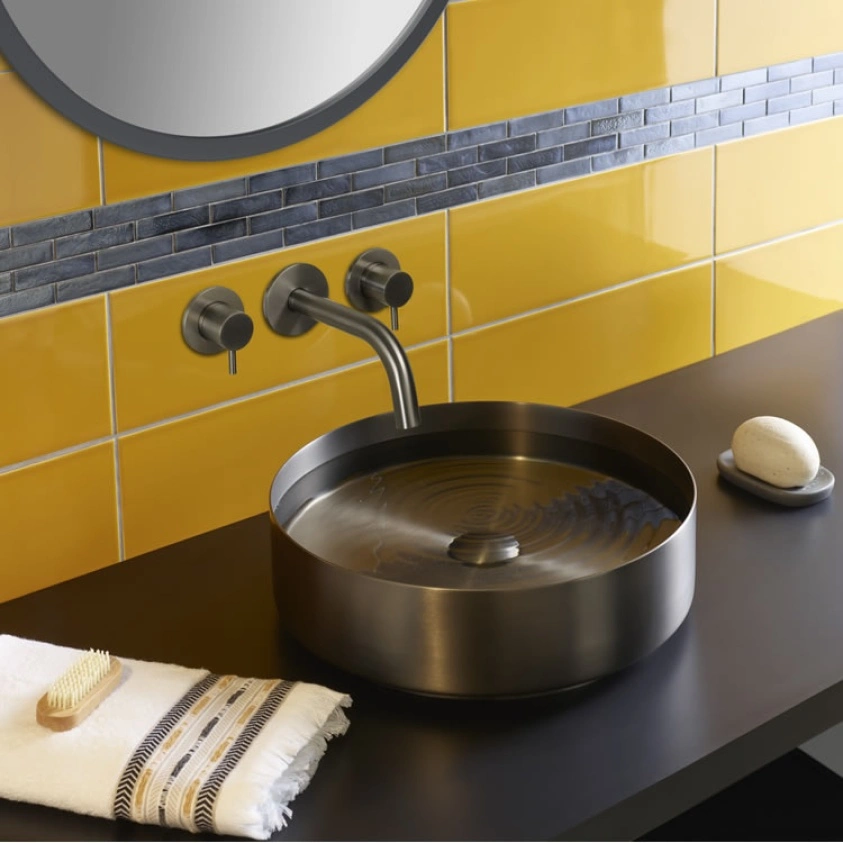
What is a Countertop Basin or Vessel Sink?
Originally coined the ‘bowl sink’ for its typically round design, the terms countertop basin and vessel sink refer to any basin that is installed on top of a flat surface, with its waste inserted into a discreet hole to create the illusion that the basin has simply been placed on top of a surface. Taking its inspiration from the sorts of traditional washstands you would expect to find in the corners of Georgian era bedrooms, which were literally bowls placed on top of bespoke wooden dressing tables, countertop basins and vessel sinks are inherently ornamental, conceived during a period of interior design that sought to celebrate even the most functional aspects of the home.
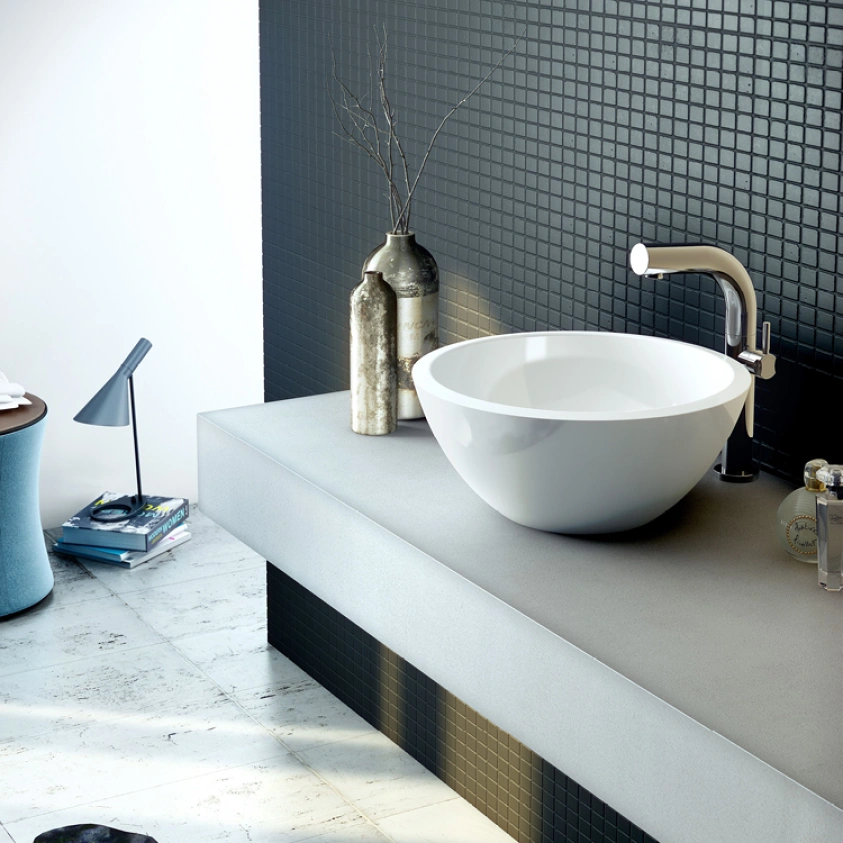
While the terms are essentially interchangeable, European manufacturers tend to use ‘countertop basin’ to describe their products while vessel sinks is more of an Americanism, despite both being the same item. For consistency, countertop basins is the phrase we will use.
How do countertop basins work and are they practical?
As outlined above, countertop basins are installed on top of any flat surface, with their waste fitted into a drilled hole and connected to your drainage system via a bottle trap or equivalent pipework. It is securely fitted from underneath the hole in conjunction with the waste fitting to avoid it moving around on a surface.
Due to their design, countertop basins are usually paired with a vanity unit to take advantage of adding some storage space. While many manufacturers produce pieces of furniture that are designed to snugly accommodate the dimensions of their countertop basins, in theory you install a countertop basin onto as large a surface as you wish, leaving plenty of space free for toiletries, decorative touches, or any accompanying brassware.
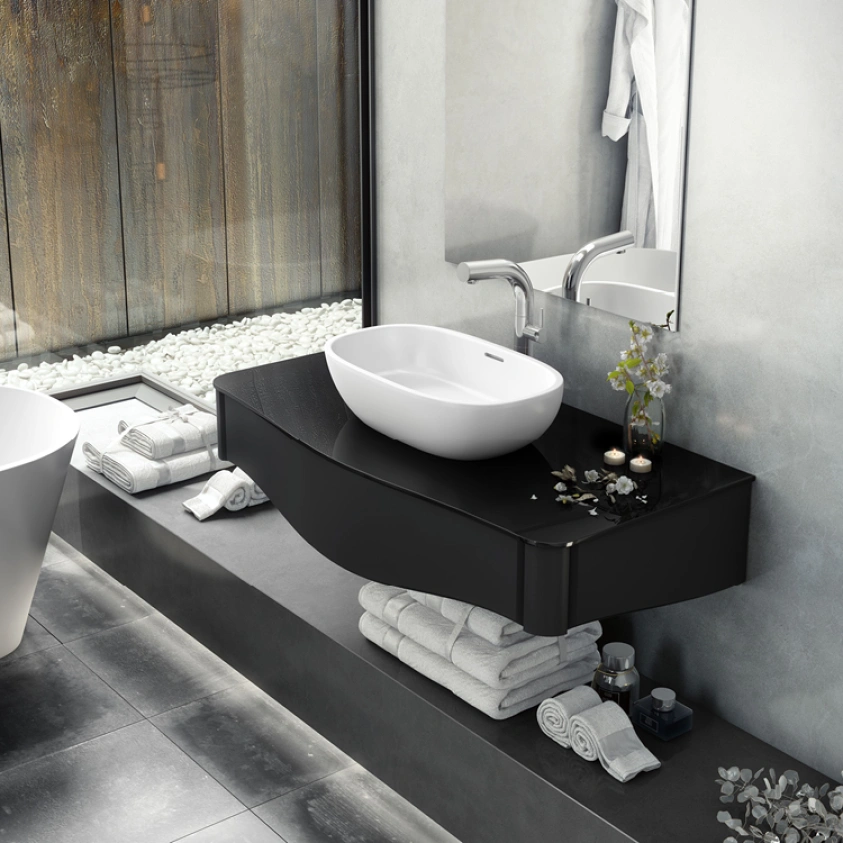
The flexibility of its installation makes the countertop basin not only an attractive but highly practical option compared to the more traditional pedestal basin, which renders the space between the basin and your bathroom floor relatively unusable for storage, while limited around the basin itself. Even semi recessed basins and inset basins, which are similar in their installation to the countertop basin, require surfaces of equal or greater depth than themselves to accommodate their installation, whereas a surface can be as thin or thick as you wish provided it is strong enough to support its countertop basin.
Are countertop basins still in style in 2024?
Even though the countertop basin can be traced back hundreds of years, the place of the countertop basin in contemporary bathroom design is more relevant than ever. After regaining their popularity in the late 2000s, countertop basins underwent a period of radical evolution as manufacturers started to experiment with different shapes and new materials that lend themselves to all manner of designs, from slimline models crafted from cutting edge composites, to textured centrepieces carved out of natural stone and even wood!
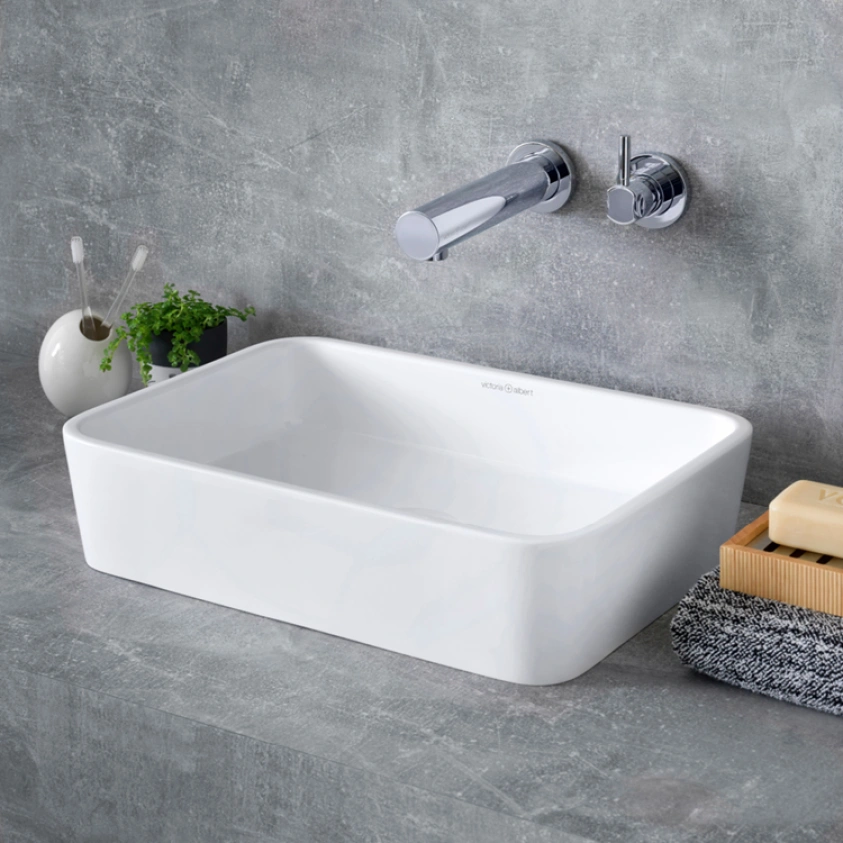
In the past two decades, the countertop basin has evolved from a playful alternative to the pedestal or wall mounted basin into a status symbol on par with the freestanding bath, popularised by social media as an eye-catching centrepiece to any space, with some manufacturers intentionally creating ranges of basins and baths identical to each other to capitalise on this. So if you are looking to not only bring your 2024 bathroom up to speed, and add something eye-catching to a room, then a countertop basin should be top of the list.
What is the typical cost of a countertop basin in 2024?
As the countertop basin has risen to the same status as the freestanding bath, it is unsurprising that its price point is just as varied has also. While smaller and simpler designs can retail for as low as £110, the most common range you can expect is between £230 and £500, although larger or more sculptural models can cost up to and even above £750.
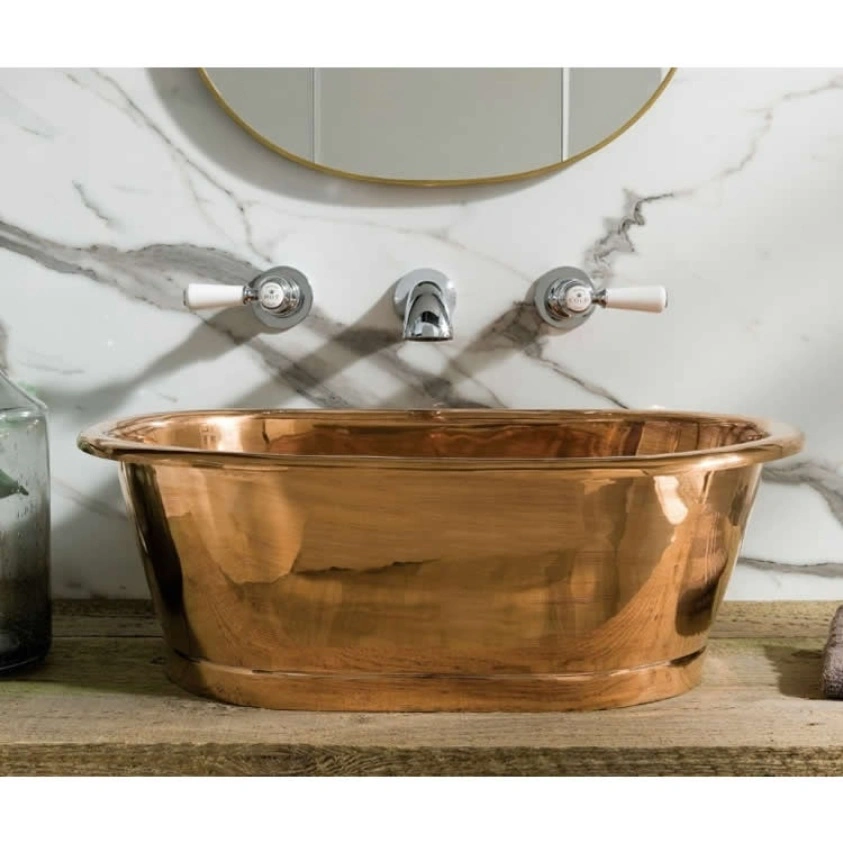
What are the most popular shapes & styles of countertop basins?
While the countertop basin started life as a round ‘bowl [shaped] sink’ and this shape has remained very popular, the unique space that the countertop basin inhabits has meant a plethora of other shapes coming on to the market. The most popular ones are:
- Round
- Oval
- Rectangular
Plus, unusual shapes that are often made bespoke or to order. This next section will unpack each particular option.
Round or Bowl Countertop Basins
While a traditional spherical ‘bowl sink’ that first graced the worktop of many mid-century homes may come to mind, perhaps the most common shape for the modern countertop basin is perfectly circular, with smooth edges, and a flat bottom. In addition to the practical advantage of holding more water with which to wash your hands or face, these round countertop basins appeal to the clean lines and straightforward geometricity that defines hotel chic, making them ideal for any bathroom striving for a refined yet luxurious décor.
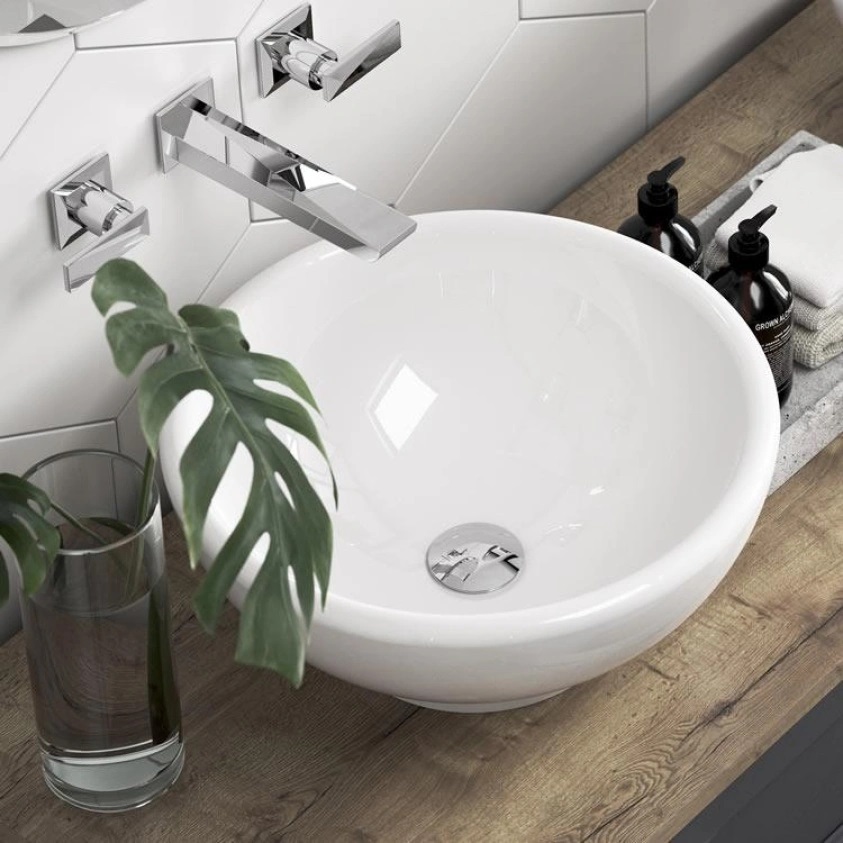
Classically bowl shaped basins are still highly sought after, their tapered bases drawing especial attention to the illusory aspect of their installation and inviting similar ornamentation in the surrounding space. For a contemporary twist, oval shaped countertop basins elongate the bowl sink form while employing a slimline edge, showcasing the advancements in modern manufacturing while providing a greater surface in which water can gather.
Rectangular or Trough Countertop Basins
Much like the aforementioned round basin, rectangular countertop basins employ strict geometricity to achieve their striking yet highly functional designs. However, in keeping with the spa aesthetic these styles of basin are attempting to emulate, their potentially sharp corners are usually softened to make them more inviting and tactile.

While more compact and even square shaped countertop basins are among the most prevalent, with many manufacturers bundling them alongside vanity units specifically designed to match their dimensions, much wider ‘trough-like’ models are becoming increasingly popular for use in family bathrooms as they can be paired with more than one mixer tap, such that multiple people can use the basin simultaneously.
Unusual and Uniquely Shaped Countertop Basins
Although much rarer, there are a number of unusual or creatively-designed countertop basins to choose from too, often with playful takes on most common shapes. It is worth caveating at this point that these are often made to order or bespoke, so not freely available on the market, and you may have to do a bit of searching.
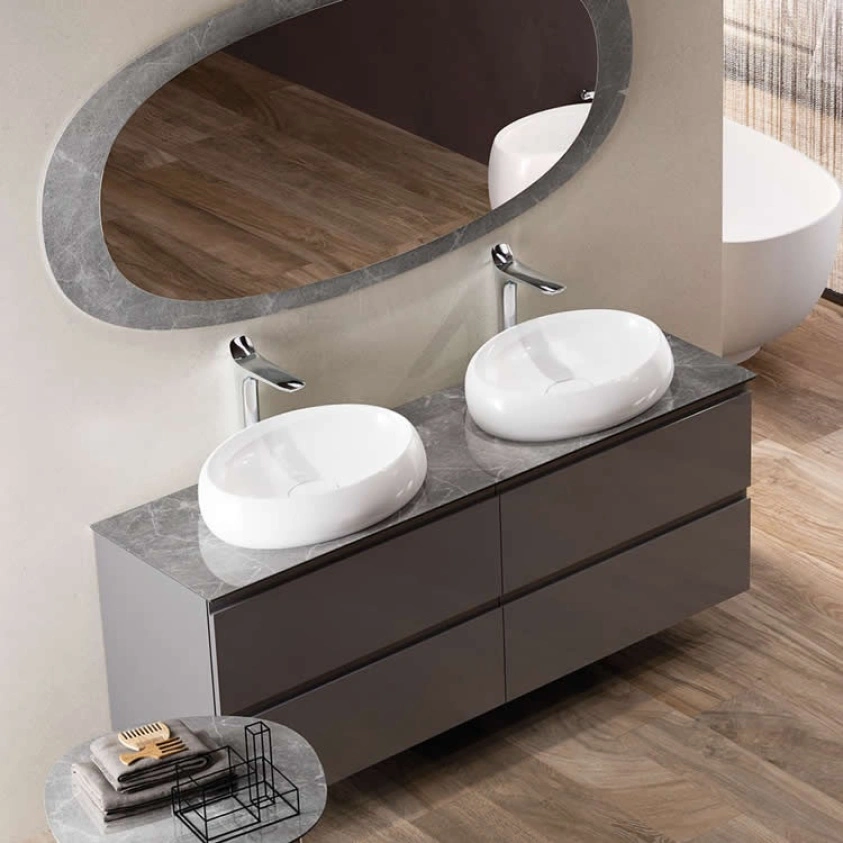
Examples of unique shapes include:
- Triangular
- Teardrop
- Egg Shaped
- Capsule
- Anything between circular and 13 sided bowls
- Sea Shell shaped
What are the typical sizes and dimensions of countertop basins?
As we touched upon while discussing rectangular ‘trough’ basins, the size and dimensions of any given countertop basin can vary widely depending on its intended use. That being said, based on the products available on our website, these are the standard dimensions to plan around:
- Width: Between 400mm and 600mm, with some round basins being as small as 300mm and some trough basins as wide as 850mm.
- Height: usually between 120mm and 180mm, with the most common height being 150mm.
- Depth: Between 300mm and 400mm, with the most common being 330mm.
What materials are commonly used for countertop basins?
When countertop basins first came back into fashion, it might be a surprise that one of the most common materials used in their manufacture was glass. Two decades later, countertop basins are most commonly made from either ceramics, metal or solid surface natural compounds, although glass options still exist.

In this section, we will highlight the benefits of each material as well as some helpful maintenance tips that will keep your countertop basin clean and pristine.
Ceramics
The most common material used in the manufacture of bathroom sanitaryware, ceramics have maintained their position by being one of the most durable materials on the market. Its strong surface is not only incredibly scratch and impact resistant but can handle extreme hot and cold temperatures. Ceramics are also non-porous.
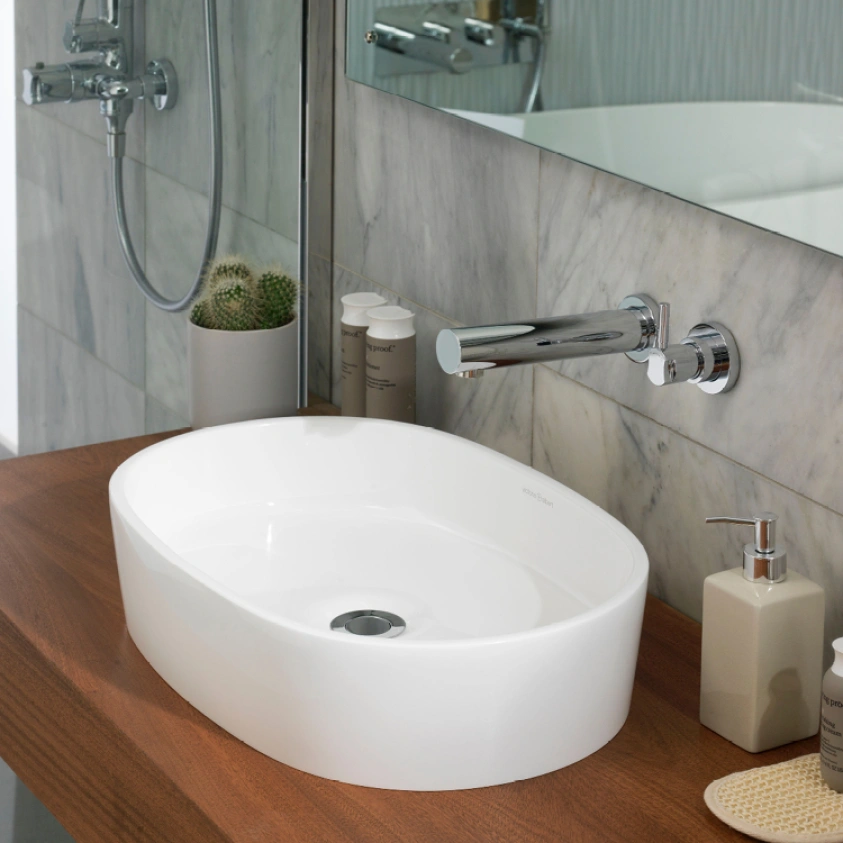
Metal
Metallic finishes are becoming more popular each year, with most of these made from stainless steel with a layer of their respective finish, such as brass, nickel or copper, applied to their surface. Stainless steel boasts the same durability and hygienic qualities as ceramics, with the added advantage of corrosion resistance.
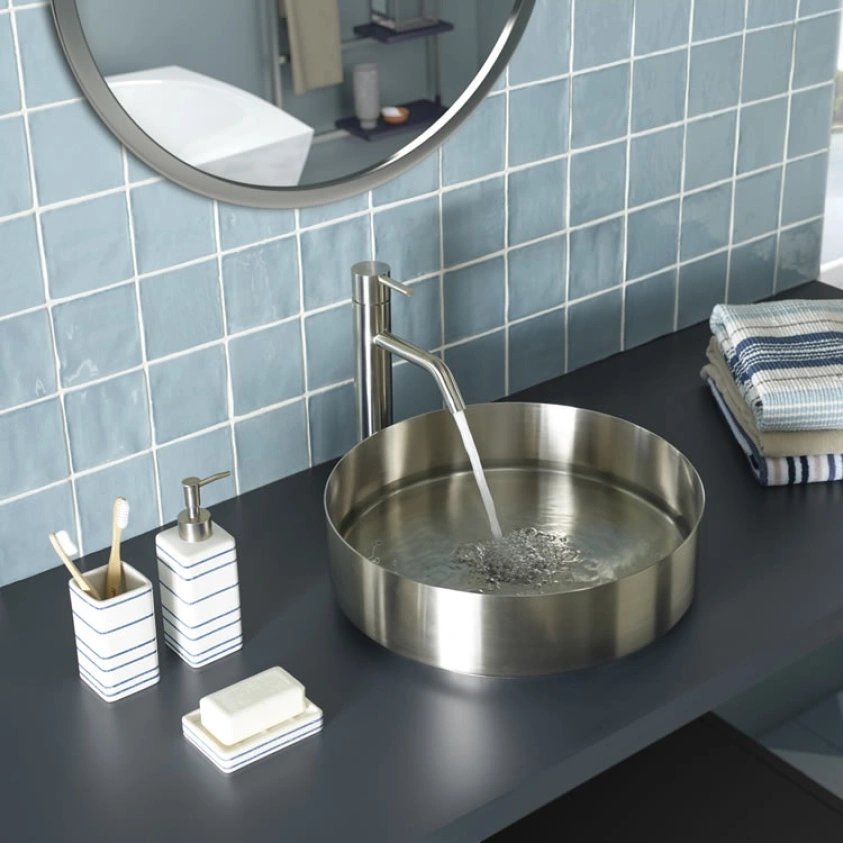
The recyclability of metal makes one of the most environmentally friendly materials on the market. So, if you are the sort of person who likes to refresh elements of their space more routinely than most, or if sustainability is an important tenant of your interior design philosophy, then metal basins might be your best bet.
Solid Surface
Made by combining acrylic with natural compounds, solid surface countertop basins are unmatched when it comes to their durability. Synthesised to make them virtually impossible to scratch or crack, solid surface basins are built to last while their namesake hard surfaces are totally impenetrable, making them resistant to bacteria as well as Ultra Violet and chemical damage to prevent them from staining or discoloration.
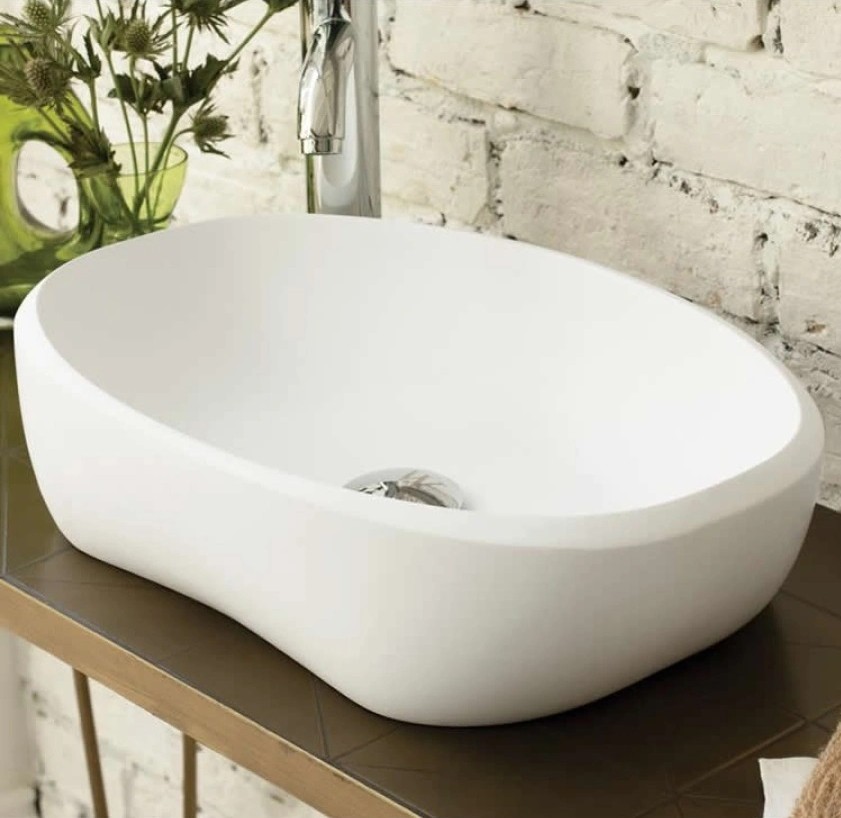
While it is possible to find basins made from ceramics or metals sporting unique shapes and exciting finishes, their versatility of solid surface means it can be moulded into almost any shape and also dyed in any colour
Are all countertop basins white or do they come in other colours?
Countertop basins are available in a spectrum of colours and finishes such that they can be coordinated with the accessories and brassware in your space, or otherwise make a statement out of your basin area. The most popular finishes are:
- White – a common fixture amongst all bathroom products
- Matt Black - Matt black has taken the bathroom industry by storm over the past few years, with everything from taps, showers, toilets and of course countertop basins boasting the illustrious finish.
- Metal finishes – There are a variety of metal finishes available including brass, copper, nickel, and even tin. These lend themselves to almost any interior style, from traditional to Industrial.
- Coloured finishes - The past few years have marked the appearance of solid surface and natural stone basins sporting some delightful pastel colours. One such range is Vado Cameo, whose Mineral Cast countertop basins in pink clay and cove blue would lend any space a retro seaside vibe. There are other colours from greige, grey, slate, cappuccino and even the opportunity to get one painted in a RAL colour of choosing!
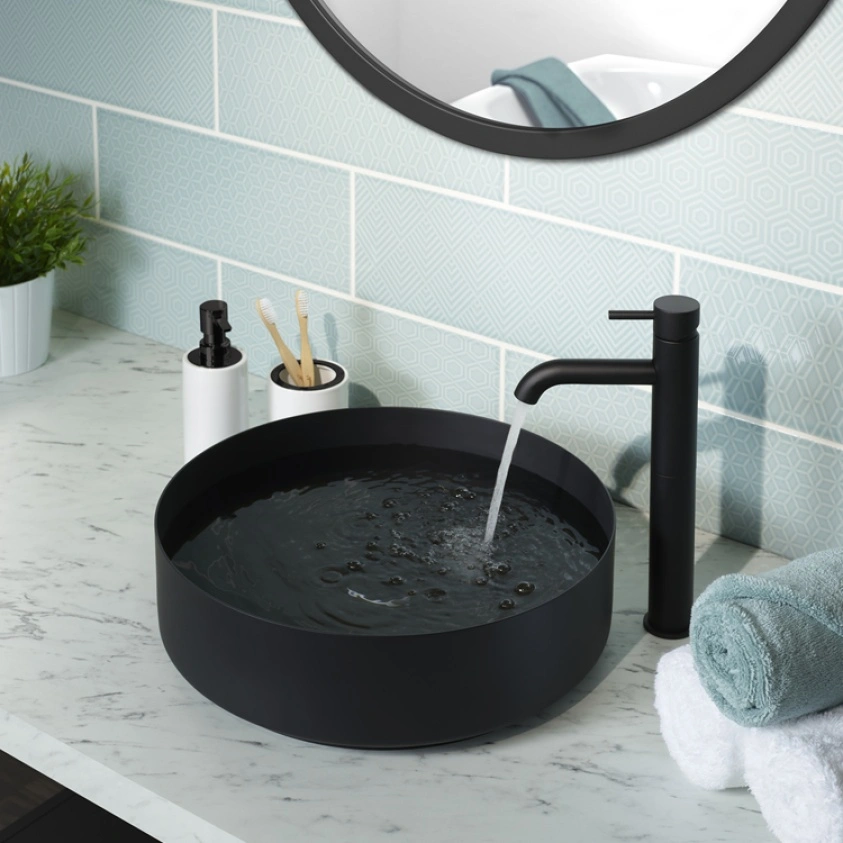
What features do countertop basins have and do not have?
Despite the minimalist and at times sculptural designs of many countertop basins, you may be surprised to find that manufacturers have found ways to incorporate classic features into their contemporary designs. This section will bring attention to these features, while offering brief explanations of their implementation:
Overflows
One of the most common features of a bathroom sink is overflows. For countertop basins, there is a mixture of those both with and without overflows. As such, it is always worth checking whether it has one, and also if this is a particular style preference as some people prefer the consistent look of the interior when picking a countertop basin.
Tap Holes
The vast majority of countertop basins will come without tap holes, meaning they can be paired with a tall basin tap or wall mounted tap with a long projecting spout to reach over the edge.

There are a select number that do offer 1 tap hole, ideal for pairing with a standard mono basin mixer tap. However, many people opt for the former option out of preference.
Do countertop basins need special wastes or drains?
Whether your countertop basin has integrated overflow or not will dictate whether your waste is slotted or unslotted respectively, but the particular function of the waste should be decided relative to the shape and size of the basin in question.
In terms of type, it really depends on the function of the basin. If it is going to be used as an everyday basin that needs filling, then opting for a simple click clack basin waste is the sensible option.
However, there are also several free flow wastes available, which stay permanently open to allow water to continuously drain away, if it is more for decorative and every day purposes, as well as minimising the risk of overfilling in the process.
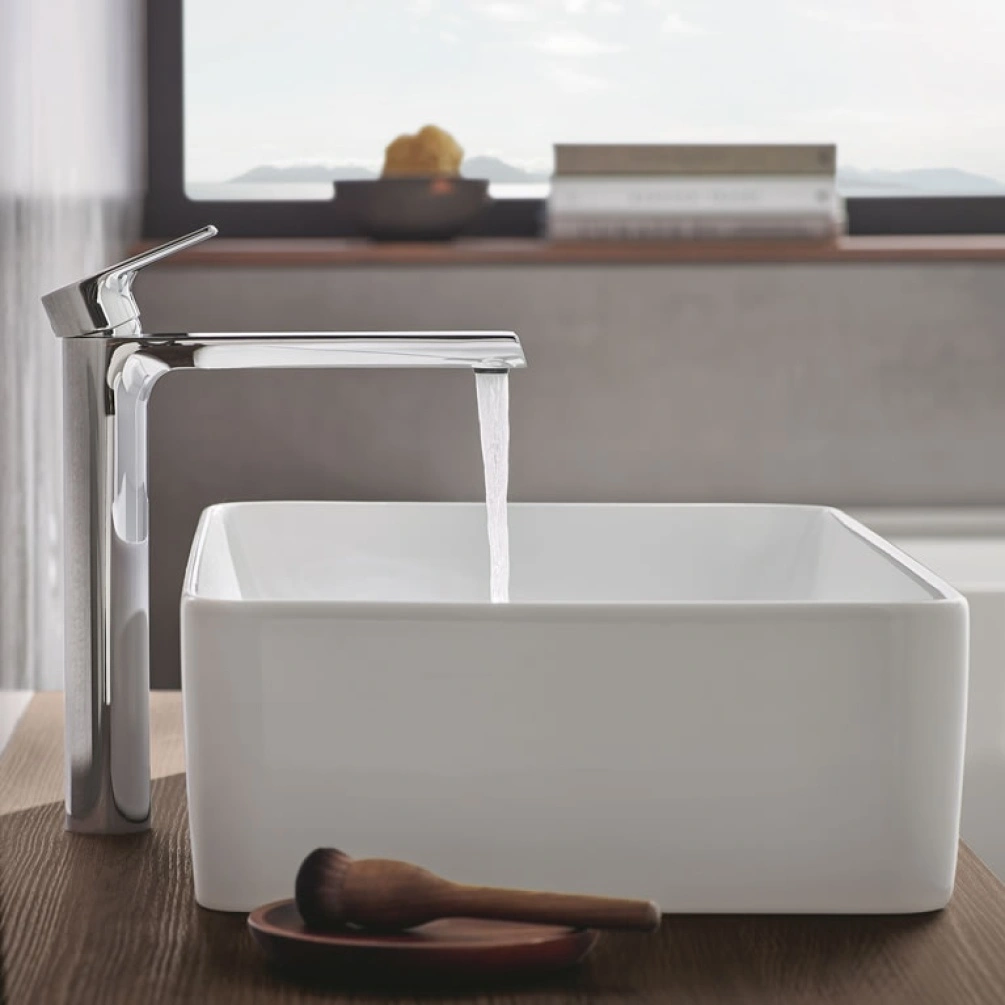
Pros and Cons of Countertop Basins
We will admit, we have been singing the praises of the countertop basin for the majority of this article, but there are always both pros and cons to every item. As such, in order for you to make an informed decision, we have summarised both here:
Pros
- Versatility: with all the different shapes, sizes, material and colours currently on the market, you are sure to find a countertop basin that is suited to the practical needs of your household, as well as the tonality of your interior style.
- Easy Installation: unlike its close cousins the semi-recessed and inset basins, you need only drill a hole into your chosen surface to facilitate the hassle free installation of your countertop basin.
- Storage Space: removing the pedestal and any mounting from the equation frees up so much space around and underneath a countertop basin that can be used for additional bathroom storage, not to mention the numerous vanity units that are specifically designed to accommodate a countertop basin on top of them.
Cons
- Maintenance: while the inside of a countertop basin is no harder to clean than any other style of basin made from the same material, the underside of bowl countertop basins are infamously difficult to maintain, with dust and grime often accumulating at the point where the bowl meets its countertop.
- Drainage: not all countertop basins have an integrated overflow and even those that do suffer from less effective drainage due to their narrower holes and slimline profiles reducing the rate of water flow.
- Height: due to countertop basins being mounted on top of items of furniture, this results in their rims being higher than most conventional basins, which can make them less accessible to young children or people with mobility issues, such as wheelchair users.

Can you put countertop basins on any furniture or do you need a specific vanity unit?
While you might prefer the practicality of a vanity unit with a predrilled hole for its respective countertop basin, there is nothing stopping you from choosing your own item of furniture or custom building a shelf to act as the surface for your sanitaryware. Enlisting the professional expertise of a carpenter and a plumber is always recommended, however if you trust your own DIY skills and are up for the challenge, this section will provide a couple of practical tips before taking a drill to the nearest sideboard or coffee table.
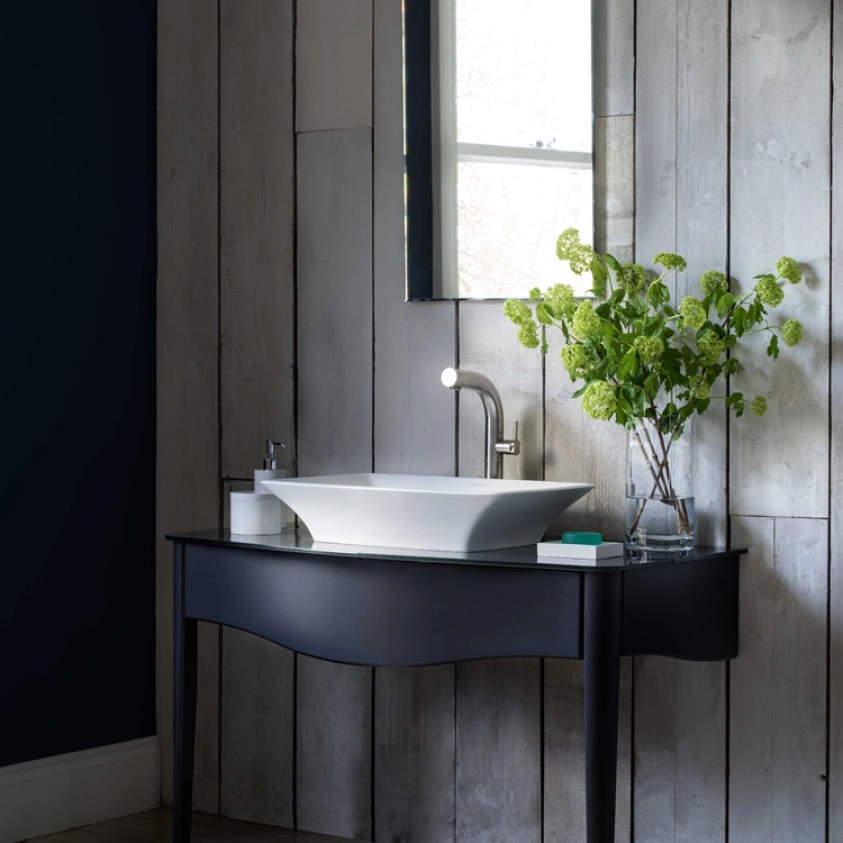
It is crucial that your countertop basin is installed on a flat surface, otherwise it could cause issues with spillage, drainage or water leaking from the site of its installation. The height of your countertop basin once located on its surface is equally important. Aim for a distance within the range of 725mm to 900mm between its rim and floor, raising or lowering its height in accordance with the needs of your household.
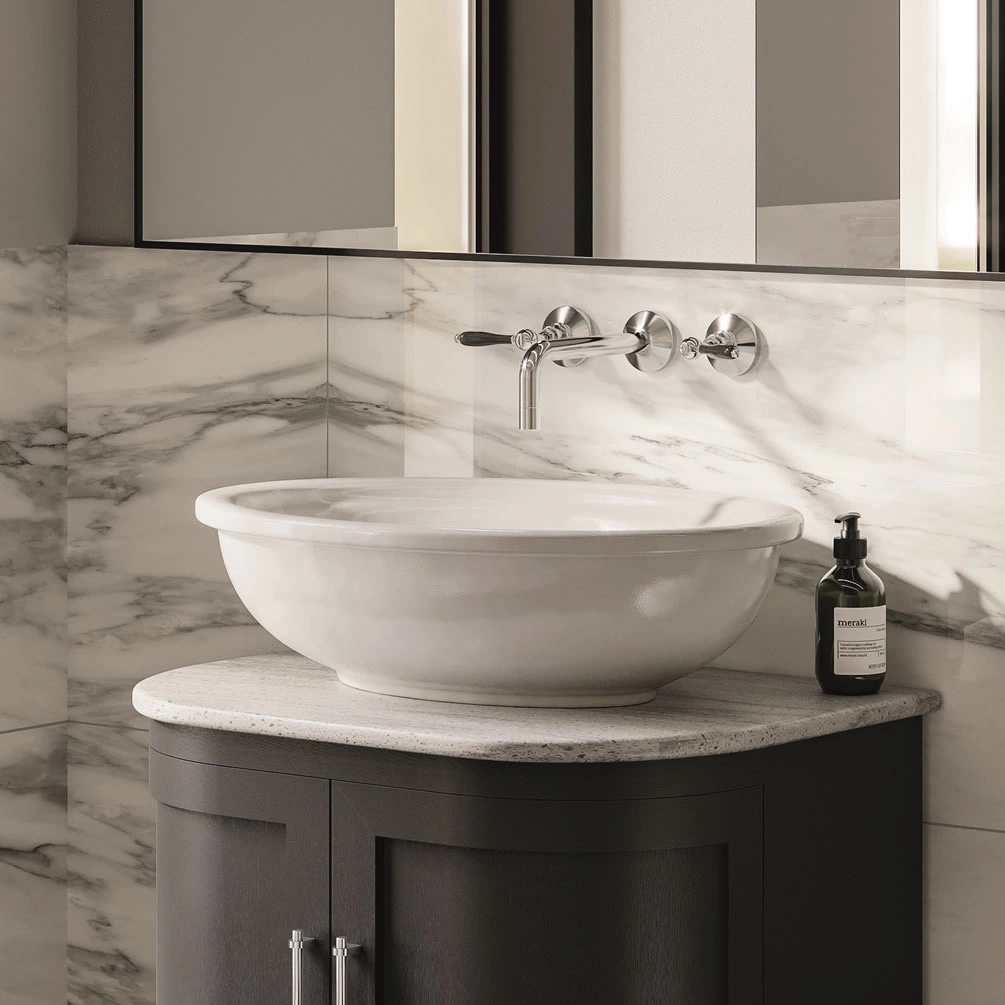
Although you can technically install a countertop basin on any surface with dimensions greater than or equal to its own, it is recommended that at least 150mm of space is left free at either side of the basin such that you still have some semblance of a functional worktop, while leaving at least 300mm between the back of the basin and your bathroom wall to accommodate your chosen brassware.
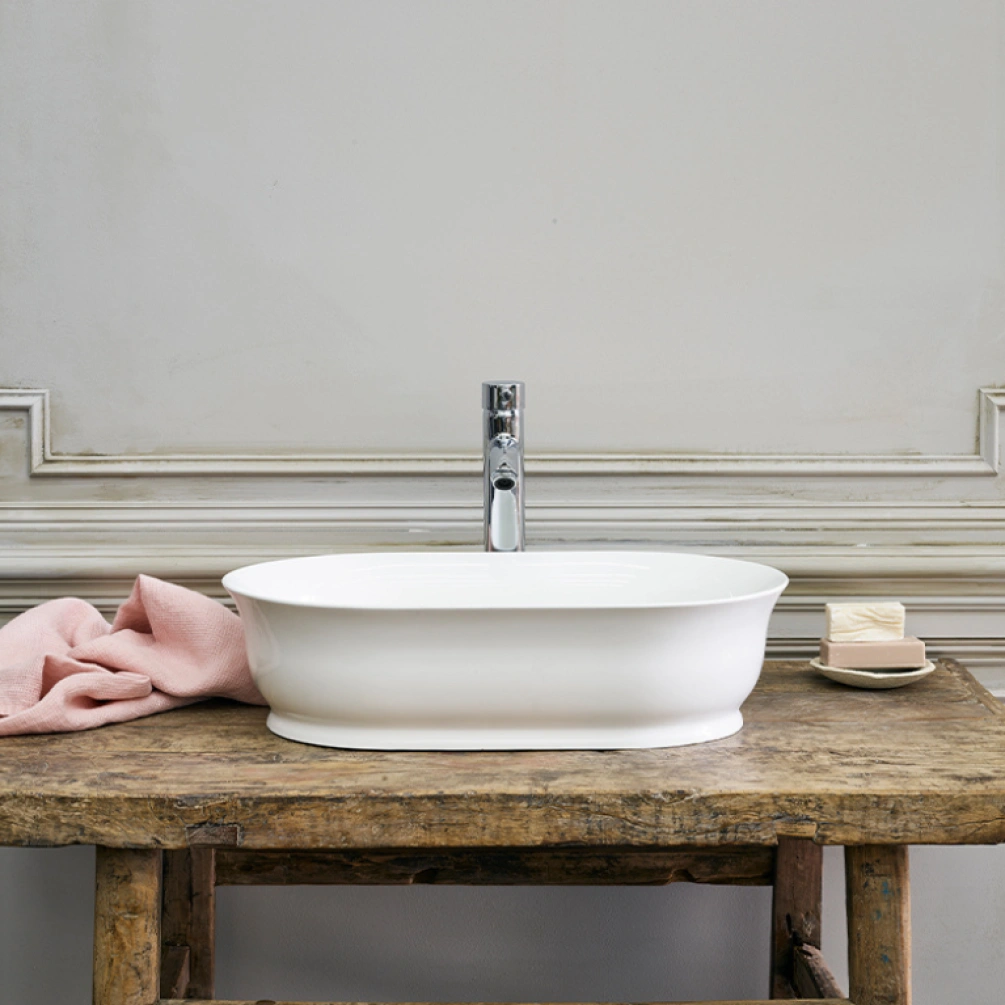
What other accessories do you need alongside your countertop basin?
This has already been covered previously in passing, however, to ensure clarity we have created this section to advise on what you need alongside a countertop basin.
This is:
- A Basin Tap – A tall basin tap that is deck-mounted or wall-mounted basin tap with the height and projection to reach over the basin edge is essential for those without tap holes. For those with a tap hole, a deck-mounted mono basin mixer tap is ideal
- A waste – For those with overflows, you will need a slotted waste of choosing. For those without overflows, an unslotted option is required
- A Bottle Trap – to connect the countertop basin and waste to plumbing
- A surface – You will need somewhere flat to put the sink, whether it is a vanity unit, built shelf, or another storage option
Do countertop basins splash more than other basins and do you need to install a backsplash for protection?
This obviously comes down to personal preference. A backsplash is a practical addition but many people don’t necessarily like it, and it is not fundamental to the operation o. The design of the countertop basin will obviously impact on splashing with shallower ones more prone to it, especially with children who may not be as cautious, and also in commercial settings if people are washing and reaching for paper towels or dryers.
However, in the everyday home setting, it is easy to place a towel nearby to minimise splashing as well as avoiding dropping water nearby, so it is unlikely to cause splashing more than any other basin.
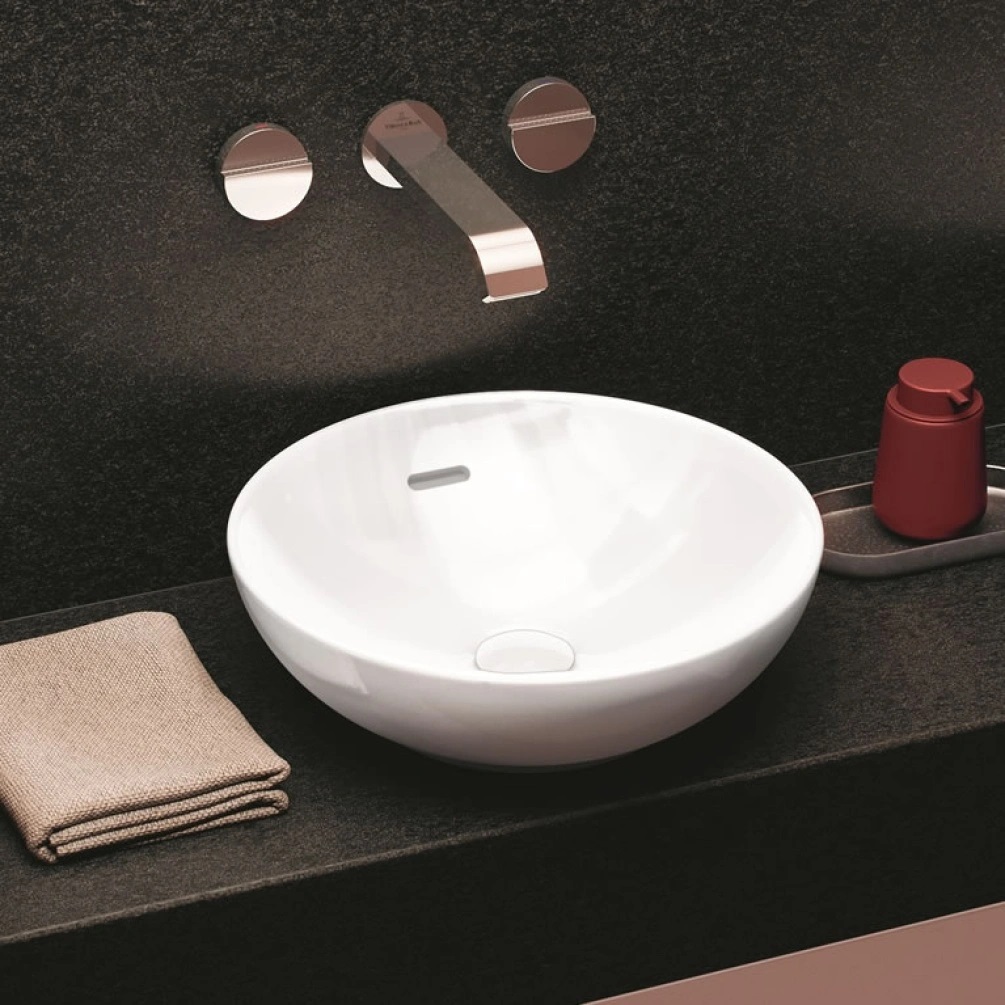
Are there any types of toilets, baths or shower that should be used alongside countertop basins?
Coherence is key to any successful design and while some contrast can help to highlight a centrepiece, clashing styles or colours can result in a discordant atmosphere that is the last thing anyone wants from their bathroom. With this in mind, we would strongly advise pairing your choice of countertop basin with the style and design it is in. As such modern countertop basins, should be paired with similarly modern toilets, baths and shower fittings. More traditional designs and colours should be paired in settings with both similar colours and period styles too.
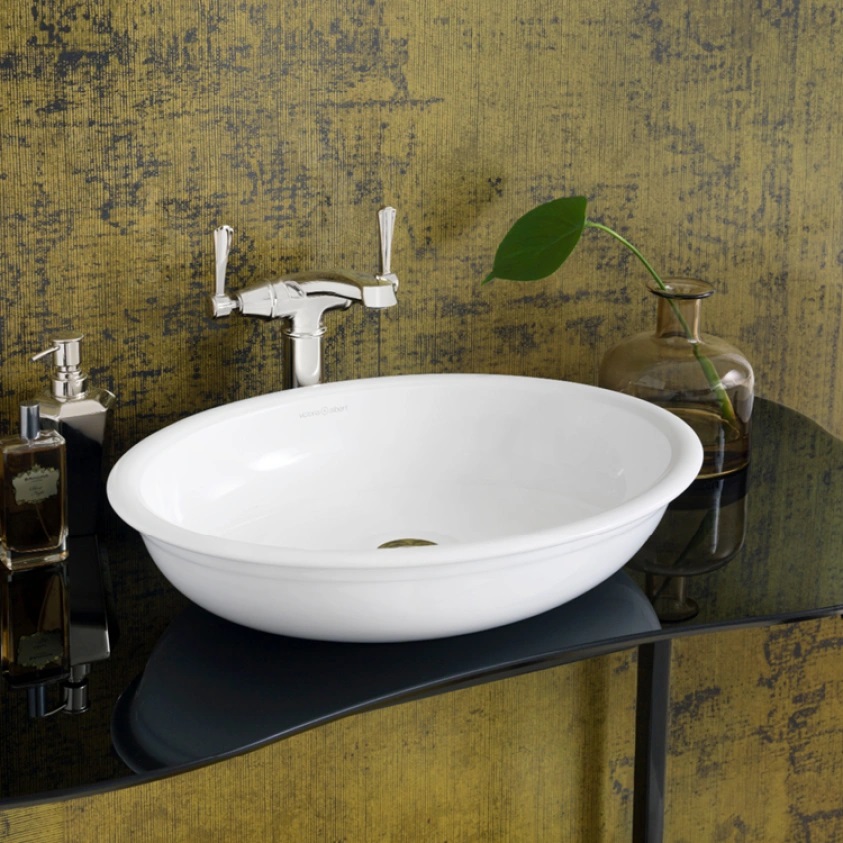
That brings the guide to countertop basins to the close. If you have any questions, or feel there is something missing from this guide, that you would like answering, please contact us and we will be glad to help.
